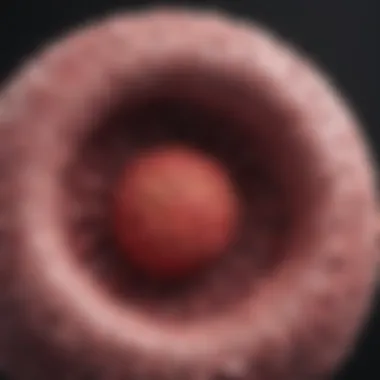Survival Rates of Ductal Carcinoma Explored


Intro
Ductal carcinoma is one of the most common forms of breast cancer. It primarily affects the milk ducts of the breast, leading to a variety of clinical outcomes. Understanding survival rates associated with this condition is crucial for both patients and healthcare professionals. By examining key factors influencing these rates, one can gain insights into treatment effectiveness and prognosis.
Survival statistics can be influenced by several variables, including tumor characteristics, treatment methods, and demographic factors. Patient age, hormone receptor status, and genetic factors play significant roles as well. A thorough exploration of these aspects provides a nuanced understanding of ductal carcinoma and its impact on survival rates. This article aims to synthesize essential findings and highlight their relevance to clinical practices and future research.
Through a critical analysis of recent studies, the complexities of prognosis are revealed. Patients and researchers will benefit from a clearer understanding of how various elements intertwine to shape outcomes in ductal carcinoma cases. As such, the discussion not only informs current treatment paradigms, but also sets the stage for future innovations in oncological care.
Research Highlights
Overview of Key Findings
This section outlines the primary insights gained from reviewing existing literature on the survival rates of ductal carcinoma. Key findings include:
- Influence of Tumor Size: Larger tumors tend to have lower survival rates compared to smaller lesions.
- Stage at Diagnosis: Early-stage diagnosis significantly enhances the chances of survival.
- Treatment Strategies: Combination therapies often lead to better outcomes compared to monotherapy.
- Demographic Variances: Factors such as ethnicity and socioeconomic status contribute to disparities in survival outcomes.
Significance of the Research
The significance of researching survival rates in ductal carcinoma extends beyond academic curiosity. Understanding these survival rates informs treatment planning and patient management strategies. Healthcare providers can tailor interventions based on patient-specific factors identified in research findings. Moreover, this knowledge fosters patient awareness and empowerment, enabling informed decision-making regarding their treatment options.
"Research is fundamental in defining the contours of patient survival in ductal carcinoma, guiding future medical practices that seek to improve outcomes."
This emphasis on evidence-based approaches cultivates a motivation for ongoing research in the field, leading to advancements that can transform the landscape of breast cancer treatment.
Original Research Articles
Summary of the Article
In exploring the various studies, this article encapsulates crucial research revolving around ductal carcinoma survival rates. Each study contributes unique data and perspectives, enriching the conversation surrounding effective treatments and outcomes.
Author Contributions
Many researchers play significant roles in this field. Their diverse contributions include clinical studies, meta-analyses, and original research articles that explore survival trends. These efforts build a comprehensive body of knowledge that serves to enhance patient care and informs best practices.
For detailed explorations of breast cancer statistics, the following resources may provide additional context: Wikipedia, Britannica or for community discussions check Reddit and Facebook.
This article promises to serve as an extensive resource for students, researchers, and healthcare professionals who seek to navigate the complexities of ductal carcinoma survival dynamics.
Prelude to Ductal Carcinoma
Ductal carcinoma, specifically ductal carcinoma in situ (DCIS) and invasive ductal carcinoma (IDC), represents a significant segment of breast cancer cases. Understanding this condition is crucial for grasping the complexities of survival rates associated with it. In this section, we will explore the characteristics, epidemiology, and incidence rates related to ductal carcinoma. A comprehensive grasp of these elements is essential, as it influences not only clinical management but also treatment approaches and patient prognosis.
Definition and Types
Ductal carcinoma refers to cancers that originate in the milk ducts of the breast. The two main types are:
- Ductal carcinoma in situ (DCIS): This is a non-invasive condition where abnormal cells are found in the lining of the breast ducts. DCIS has not spread beyond the ducts into the surrounding breast tissue.
- Invasive ductal carcinoma (IDC): This type begins in the ducts but invades nearby tissue, leading to potential spread (metastasis) to other parts of the body.
Both types exhibit differing biological behaviors, risk factors, and treatment responses, which directly correlate with survival outcomes. For instance, patients diagnosed with DCIS generally have a favorable prognosis, whereas IDC presents more complexity in its management and survival projections.
Epidemiology and Incidence Rates
Epidemiological studies indicate that ductal carcinoma is among the most common breast cancer types. For example, data from the American Cancer Society suggests that nearly 80% of breast cancer cases are classified as invasive ductal carcinoma.
Key Points on Epidemiology:
- The incidence of ductal carcinoma increases with age, particularly after the age of 50.
- Certain demographic factors, including gender, race, and genetic predisposition, also influence risks.
- Women of African descent have been reported to have a higher incidence and more aggressive form of IDC compared to Caucasian women.
Trends in Incidence Rates:
- The rate of ductal carcinoma has fluctuated over recent decades due to improved screening practices and increased awareness of breast cancer.
- The advent of mammography has contributed to early detection, particularly in DCIS cases, allowing for timely intervention and better survival rates.
Understanding the epidemiological framework helps in devising tailored strategies for screening and treatment, ultimately improving patient outcomes.


Understanding Survival Rates
Survival rates serve as a critical cornerstone in the realm of oncology. They provide not only a quantitative assessment of patient outcomes but also offer insights into the broader implications of disease management. In the context of ductal carcinoma, which is among the most prevalent types of breast cancer, grasping the concept of survival rates becomes indispensable.
A survival rate essentially estimates the percentage of patients who remain alive for a specific period following their diagnosis. These statistics are crucial as they inform both patients and healthcare professionals about the potential prognosis and effectiveness of various treatment strategies. By understanding survival rates, stakeholders can make better-informed decisions, tailor treatment plans, and set realistic expectations regarding outcomes.
Moreover, survival rates are influenced by a myriad of factors, such as tumor characteristics, the stage at diagnosis, and patient demographics. Each of these elements can significantly affect the overall prognosis, rendering a comprehensive understanding vital for developing effective treatment protocols. Assessing survival rates helps medical practitioners identify trends over time, guiding future research and resource allocation.
Definition of Survival Rate
The term "survival rate" refers to the proportion of individuals diagnosed with a particular illness who remain alive at a specified point in time. In oncology, it is typically expressed as a percentage and can vary depending on multiple factors, such as:
- Duration: Commonly assessed at intervals like one, three, or five years post-diagnosis.
- Type of cancer: Different cancers exhibit varied survival rates based on their biology and treatment regimens.
- Stage at diagnosis: Earlier-stage cancers generally correlate with higher survival probabilities compared to advanced stages.
For ductal carcinoma, the five-year survival rate is often used as a standard measure. This statistic provides a snapshot of how well current treatments are performing and highlights potential areas for improvement in patient care and clinical practices.
Importance in Oncology
Understanding survival rates holds substantial weight in oncology for several reasons:
- Patient Empowerment: Knowledge of survival rates enables patients to engage more actively in their treatment choices. An informed patient can discuss options better with healthcare providers.
- Strategic Planning: For oncologists, survival rates inform treatment plans. By understanding statistical outcomes, they can select personalized approaches that optimize patient chances of survival.
- Research Directions: Trends in survival rates illuminate areas that require further investigation. Researchers can identify gaps in treatment efficacy, leading to the development of novel therapies.
- Healthcare Policies: Survival statistics can influence healthcare policies and funding allocation, ensuring resources are directed toward effective interventions that enhance patient outcomes.
"Survival rates are not just numbers; they represent real lives and experiences, guiding clinical decision-making and offering insights into the future of oncological care."
In summary, understanding survival rates is imperative for both patients and medical professionals. It translates statistical data into actionable insights that can shape treatment pathways and enhance care quality.
Statistical Overview
The statistical overview of ductal carcinoma survival rates serves as a critical foundation for understanding the prognosis of this common breast cancer type. Such statistics not only inform patients and healthcare providers about potential outcomes but also guide treatment decisions and research directions. Knowledge of survival rates helps in drawing comparisons between different demographic groups and treatment methodologies, allowing for a nuanced understanding of how various factors influence patient outcomes.
Exploring these statistics offers several benefits, including:
- Identifying Prognostic Indicators: Statistics enable clinicians to recognize how specific traits of the tumor or patient might affect survival.
- Guiding Treatment Protocols: Understanding survival data can lead to more effective treatment planning tailored to individual cases.
- Enhancing Research Validity: Accurate statistical insights underpin new research initiatives focusing on improving survival rates and patient quality of life.
Statistics can vary widely based on multiple elements. These include but are not limited to:
- Clinical stage at diagnosis
- Age, race, and overall health of the patient
- Specific tumor characteristics, such as size and hormone receptor status
This underscores the importance of an in-depth analysis, which allows for a more thorough understanding of not just average survival rates but the variability therein. The following sections will delve deeper into general survival rates, specific survival rates by cancer stage, and long-term survival trends to paint a comprehensive picture of ductal carcinoma outcomes.
General Survival Rates for Ductal Carcinoma
Data shows that ductal carcinoma has various survival statistics depending on numerous influencing factors. Generally, the five-year survival rate for ductal carcinoma patients is high, hovering around 90% when detected early. However, this figure declines considerably with later-stage diagnoses. Such statistics are crucial as they help to establish benchmarks that patients and oncologists can reference.
Five-Year Survival Rates by Stage
Survival rates fluctuate significantly based on the stage of cancer at diagnosis. The following overview outlines common survival rates:
- Stage 0 (Ductal Carcinoma In Situ): Nearly 100% five-year survival rate.
- Stage I: Around 90% five-year survival rate.
- Stage II: Approximately 75-80% five-year survival rate.
- Stage III: Between 50-70% five-year survival rate.
- Stage IV: Less than 30% five-year survival rate.
This stark contrast highlights the critical nature of early detection. Early diagnosis significantly increases the chances of successful treatment and survival.
Long-Term Survival Trends
Long-term survival trends in ductal carcinoma display notable improvements over the decades, owing largely to advances in treatment and increased awareness around early detection. Recent data indicates that the long-term survival rates continue to improve as therapies become more refined. Most of the statistics show that women diagnosed in recent years have a much better prognosis than those diagnosed 20 or 30 years ago.
Key trends include:
- Advancements in targeted therapies have led to improved survival rates, particularly in hormone receptor-positive cases.
- Increased screening efforts have facilitated earlier diagnosis, hence better outcomes.
Changes in treatment strategies and a growing emphasis on personalized medicine are expected to further enhance survival going forward. Continuous research and innovation within oncology strive to maintain this positive trend and improve the overall quality of life for patients.
Factors Influencing Survival Rates
The survival rates of patients with ductal carcinoma are shaped by a multitude of factors. This section focuses on eight main influences that significantly mold these outcomes. Understanding these factors is crucial not only for researchers but also for clinicians and patients. It allows for a nuanced view of individual prognoses and treatment plans.


Tumor Characteristics
Tumor characteristics are fundamental in determining survival rates. Key features such as size, histological grade, and hormone receptor status can alter treatment responses and outcomes.
Size
The size of the tumor is a critical determining factor for survival. Larger tumors tend to lead to worse outcomes. A smaller size generally indicates earlier-stage disease and might correspond with a better prognosis. This insight makes size a popular choice for consideration in survival studies, as it can guide treatment approaches.
Unique features of tumor size relate to detection time. Early detection often means smaller tumors, which are generally less aggressive and easier to treat. Conversely, larger tumors might indicate advanced disease, which complicates treatment and worsens prognosis. Thus, size serves as an essential marker in assessing survival odds.
Histological Grade
Histological grade refers to how abnormal the cancer cells appear under a microscope. Higher grade tumors tend to grow and spread more aggressively, which can adversely affect survival rates. This information is invaluable in an analytical context, as it assists in identifying potential treatment responses and informing therapy choices.
The grading system helps categorize tumors, enabling healthcare providers to tailor treatment. A high-grade tumor's unique feature is its potential for rapid progression, requiring aggressive treatment strategies to improve outcomes. This underscores the need for detailed histopathological assessment in the management of ductal carcinoma.
Hormone Receptor Status
Hormone receptor status indicates whether ductal carcinoma cells have receptors for hormones like estrogen or progesterone. This characteristic plays a significant role in dictating treatment pathways. Tumors that are hormone receptor-positive often respond well to hormone therapy, potentially improving survival rates.
The unique advantage of assessing hormone receptor status lies in its guidance for personalized treatments. When a tumor is hormone receptor-negative, it may require different therapeutic approaches, typically involving chemotherapy. Consequently, this factor is essential in developing tailored treatment plans to optimize patient outcomes.
Patient Demographics
Demographic factors such as age, race, and socioeconomic status also wield considerable influence on survival rates. They shape access to care, timing of diagnosis, and even response to treatment.
Age
Age is a pivotal demographic factor in survival outcomes. Younger patients often experience better survival rates compared to older individuals. This discrepancy can be attributed to various reasons, including the biological behavior of tumors and the overall health of patients. Younger individuals may have a better ability to withstand aggressive treatments as well.
The unique aspect of age is its correlation with the development of comorbid conditions. Older patients often contend with other health issues that can complicate treatment possibilities, impacting their overall prognosis.
Race
Race can significantly influence survival outcomes. Disparities exist based on genetic, biological, and environmental factors inherent to different racial groups. Some studies indicate that Black women have lower survival rates compared to white women.
The unique characteristic of race is its complexity, involving various societal factors that affect healthcare access, treatment options, and cultural perceptions regarding illness. This variance makes it essential for oncologists to consider race while developing patient management strategies.
Socioeconomic Status
Socioeconomic status is another determinant of survival outcomes. Patients from lower socioeconomic backgrounds may experience barriers to optimal care, such as limited access to healthcare resources, lack of insurance, or inadequate transportation.
This factor is particularly critical in understanding survival rates since it encompasses a wide range of health determinants. Unique features of socioeconomic status highlight disparities in treatment adherence and early detection of disease, which are crucial for improving patient outcomes.
Treatment Modalities
Treatment options significantly influence survival rates for ductal carcinoma. Across various approaches, the choice of strategy often correlates to the tumor characteristics and patient profile.
Surgical Options
Surgical intervention is often the first line of treatment for ductal carcinoma. Options can range from lumpectomy to mastectomy, depending on the tumor's stage and type. The success of these interventions adds to the survival rates, with many studies showing favorable outcomes for early-stage disease treated surgically.
The decision process in surgery is critical. A unique feature is the need for meticulous planning, considering not just tumor characteristics but also patient preferences and overall health, which can inform the best surgical approach for a given individual.
Radiation Therapy
After surgery, radiation therapy often plays an essential role in improving survival rates, particularly for patients who have undergone breast-conserving surgery. This treatment helps eliminate residual cancer cells, contributing to better outcomes. It is especially important in high-risk situations.
The unique aspect of radiation therapy is its adjunct role. While it is not typically a standalone treatment, its impact in conjunction with surgical options is profound, reinforcing its value in treatment protocols.
Chemotherapy
Chemotherapy remains a common treatment option for ductal carcinoma, especially in cases where the disease is more advanced or has specific features necessitating systemic therapy. The effectiveness of chemotherapy is often tied to the tumor’s characteristics, particularly hormone receptor status and grade.
Chemotherapy has a unique role in providing a systemic approach, targeting cancer cells that may have spread beyond the primary site. However, its side effects can be significant, necessitating careful management and consideration of patient preferences and overall health during treatment planning.


Understanding these factors influencing survival rates is paramount. Collectively, they paint a comprehensive picture enabling better decision-making regarding treatment and prognostics.
Current Research Trends
Research in ductal carcinoma is advancing rapidly. Understanding current trends is crucial. These trends reveal how scientists tackle the complexities of this cancer type. This section focuses on the emerging therapies and the role of genetic testing. Both aspects contribute significantly to improving patient outcomes.
Emerging Therapies
Emerging therapies offer hope for patients with ductal carcinoma. New treatment approaches go beyond standard chemotherapy and radiation. They aim to improve efficacy and reduce side effects. Recent studies highlight several promising options:
- Targeted Therapies: These treatments focus on specific molecules involved in cancer growth. Examples include trastuzumab for HER2-positive cancers. They can lead to better survival rates.
- Immunotherapies: This approach helps the immune system combat cancer cells. Drugs like pembrolizumab show potential in early studies. They might improve outcomes for some patients.
- Combination Therapies: Many researchers are exploring the benefits of combining different treatments. For instance, pairing chemotherapy with targeted therapy may enhance effectiveness.
As trials continue, we gather more pertinent data to assess these therapies. That allows oncology professionals to tailor treatments to individual patients, improving the overall quality of care.
Genetic Testing and Personalized Medicine
The rise of genetic testing alters how ductal carcinoma is addressed. Personalized medicine has the potential to refine treatment plans significantly. Genetic tests can identify mutations and characteristics unique to each tumor. This information helps oncologists make informed decisions about therapy. Key points to consider include:
- HER2 Status: Testing for HER2 can determine if targeted therapies are appropriate.
- BRCA Gene Mutations: Patients with these mutations may benefit from specific treatments. PARP inhibitors, for example, are designed to target cancers resulting from BRCA mutations.
- Tumor Profiling: Understanding the genetic profile of tumors can guide therapy selection. This helps to avoid ineffective treatments and focus on what might work best.
"Genetic testing plays a crucial role in personalizing treatment strategies for patients with ductal carcinoma."
As research progresses, we see a clearer picture of how these tests impact survival rates. Insights from these advancements enable oncologists to offer more precise, effective care to their patients.
Survivorship and Quality of Life
Survivorship and its impact on quality of life are critical components in understanding the journey of individuals who battle ductal carcinoma. Survivorship goes beyond mere survival; it encompasses the holistic well-being of patients after undergoing treatment. The intricacies involved in recovery and life after a cancer diagnosis can significantly affect both physical and mental states. Ensuring optimal quality of life is essential for improving patient outcomes and promoting long-term well-being.
Post-Treatment Health Challenges
Post-treatment health challenges are prevalent among survivors of ductal carcinoma. These challenges can hinder a person's ability to return to their daily routines. Common issues include fatigue, pain, and changes in physical appearance. Survivors might also face ongoing health concerns, such as lymphedema, which can cause swelling and discomfort in extremities. Managing these symptoms requires a coordinated approach involving medical professionals.
Some survivors experience hormonal changes, particularly if the cancer is hormone-receptor-positive, which can lead to menopausal symptoms such as hot flashes and mood swings. Fatigue, often described as debilitating, continues to affect many long after treatment ends. The interplay of these factors complicates the recovery process and requires heightened awareness among healthcare providers.
Psychosocial Support Systems
Psychosocial support systems play a vital role in post-treatment recovery. These systems can include family support, community groups, and professional counseling. Engaging with others who have had similar experiences can provide invaluable emotional relief and help in navigating life after treatment.
Professional support from psychologists or social workers may also assist survivors in coping with feelings of anxiety or depression. It is important to address psychological aspects alongside physical recovery. Support groups or therapy can foster a sense of belonging and validation, which many survivors find beneficial.
Furthermore, organizations specializing in cancer support can offer resources like educational materials and workshops focusing on coping strategies. Utilizing these resources can greatly enhance the quality of life for individuals following ductal carcinoma treatment, ensuring they feel supported and informed throughout their recovery journey.
"The journey of survivorship is not solely defined by the absence of disease but by the presence of support, understanding, and empowerment."
Ending
Understanding the survival rates of ductal carcinoma is essential in the field of oncology. This topic reflects the effectiveness of current treatment modalities and provides insights into patient outcomes. The complexities within this analysis reveal not only the prognosis of individuals diagnosed with this form of breast cancer but also the underlying factors that significantly impact survival. These factors include tumor characteristics, patient demographics, and the stratification of treatment options.
Summary of Key Findings
In summary, the article highlights several key points regarding ductal carcinoma survival rates:
- General Survival Rates: The overall survival rates for ductal carcinoma have shown improvements over recent years due to advances in medical treatments and early detection strategies.
- Stage-Specific Rates: Survival rates vary significantly by stage. For instance, early-stage cases exhibit markedly higher five-year survival rates compared to late-stage presentations, underscoring the importance of timely diagnosis.
- Influencing Factors: Characteristics such as tumor size, hormone receptor status, and histological grade play critical roles in determining survival outcomes. Additionally, patient-related factors, including age and socioeconomic background, also contribute to overall prognosis.
This summary encapsulates vital statistics and insights that are crucial for ongoing discourse in cancer treatment and research.
Future Research Directions
Future research in the field of ductal carcinoma should focus on several key areas:
- Longitudinal Studies: Conducting long-term studies to evaluate how new treatment regimens affect survival rates over time.
- Genomic Research: Expanding investigations into the genetic underpinnings of ductal carcinoma. Unraveling these aspects can aid in the development of targeted therapies, leading to more personalized treatment approaches.
- Quality of Life Assessments: Investigating the psychosocial impacts of ductal carcinoma on survivors and how to enhance their quality of life post-treatment.
- Health Disparities: Exploring the disparities in survival rates among different demographics to create more equitable healthcare solutions.
Ongoing research must engage with these elements to refine treatment strategies and improve patient outcomes. Integrating findings from various studies will be essential as we advance towards a more nuanced understanding of ductal carcinoma and its implications in oncology.
Citations and Further Reading
For those interested in exploring the survival rates of ductal carcinoma further, several resources stand out. These references offer deeper insights that complement the analysis provided in this article:
- American Cancer Society: Detailed statistics on breast cancer survival rates and risk factors can be accessed through their official site.
- PubMed: An extensive database of scientific articles and studies that cover recent advancements in cancer research, including ductal carcinoma.
- NCI (National Cancer Institute): Offers comprehensive data and statistics on various cancer types, including ductal carcinoma, along with information on treatment options.
Overall, these resources can enrich understanding and provide context to the data discussed in this article.







